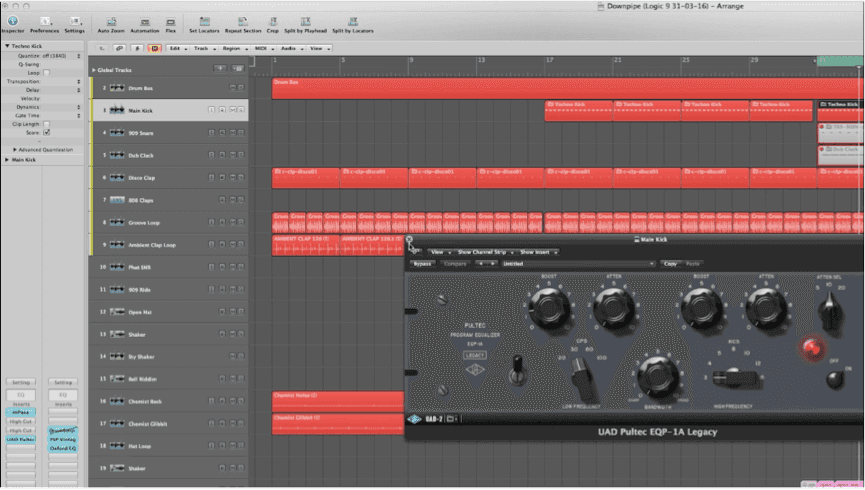Released in 2009, ‘Downpipe’ was a bold statement from Mark Knight, D.Ramirez and Toolroom. A record that took nearly 12 months of pain-staking production, it featured the legendary Karl Hyde of Underworld on vocals – big moves from a label that at the time was only on the start of a journey towards its powerhouse status, and from two producers who were established, but still on their paths towards international recognition.
Now recognised as a bona fide anthem, and still one of the top-selling tracks from Toolroom’s extensive catalogue, ‘Downpipe’ propelled the careers of Mark Knight and D.Ramirez and elevated the reputation of Toolroom. To this day, it is still the record Mark is proudest of.
To mark the release of the Toolroom Academy course on Downpipe – an in-depth, behind the scenes tutorial on how this record was made – we have decided to tell the story of the track, with contributions from the key players involved in bringing this seminal release together.
‘I first became aware of Mark as a producer back in 2004 when I was sent his ‘Filthy House EP’, which was at the time going to be the first release on Toolroom’, remembers Dean. ‘As soon as I heard it, I just thought…wow, this guy has obviously got it.’ After being introduced by a mutual friend, Mark travelled up to visit Dean’s studio in Sheffield. Their aim was simply to see if they would click in the studio. ‘I was well aware of Dean’s reputation and prowess in the studio, so I was keen to hear what we could create together’ says Mark. ‘We did a track and it was cool, but not exactly what we wanted to achieve. That’s the thing with production partnerships – it often takes time to gel and figure out each other’s best roles.’
It wasn’t until over a year later when the pair finally finished something – and in doing so, they found a sound that they had been trying to capture.
The Colombian Soul EP, released on Toolroom Trax in 2007, instantly sounded different from the majority of house music being produced at the time. The B-sides ‘System’ and ‘Throb’ had been worked on for some time, but it was the lead track – inspired by the pair’s tour of Colombia – that really stood out. ‘Colombian Soul was a piece of music that was everything we wanted’ says Dean. ‘ It was dark, but it was melodic. It had energy. It was the start of something for us.’
‘What we had wanted to achieve was a more electronic sound – but fused with the more tribal grooves that we were both feeling’ agrees Mark. ‘In doing this with Colombian Soul, we almost created our own sub-genre, our own niche.’. With Colombian Soul acting as a starting point, in 2008 Mark and Dean began working on the follow-up. All they knew was that they wanted to elevate what they had done – to create something that would be a calling card for themselves, a track that would last the test of time.
Mark and Dean knew exactly what they wanted to achieve when they sat down to write Downpipe in late 2007. This is often where a lot of producers fall down – they start a computer not really knowing what they are aiming for, often leading to quite a generic piece of music. With Downpipe, Mark and Dean had a new sound, and a big ambition – to write a track they could play at the main stage of big festivals, with Karl Hyde from Underworld on vocals.
But before they could even approach Karl, they needed to present him with something that was a high enough level for him to work on. Mark’s plan with Downpipe was to create a journey, a real progression in the track’s arrangement that led to a big melodic pay-off. So what was needed was to create space for that melody.
‘The initial skeleton backing track came together quite quickly’ reveals Dean. ‘With the drums and percussion – we just wanted a straight rhythm, nothing too complicated, to leave space for extra rhythmical parts. With the bass, we wanted a weighty bottom end, nothing too tonal. Just something that added size and weight so that it would sound huge in festivals
‘Drums and bass are the two things you primarily hear in a club environment’ says Mark. ‘It’s really important you get a signature sound in your drums, even if they are simple. When you hear an anthem in the studio, you recognise it right away from the rhythm section. I think that’s what you get from Downpipe’.
If the aim with the track was to tell a story – with a big melodic pay off – then the arrangement of the track had to be clever. How did they do this?
‘We created enough attention early on in the track without giving the game away. We did this by making lots of layers of sound, with lots of syncopation’ explains Mark. ‘We keep the interest going all the way to the 4.15 mark, when the main melody appears.’
The main riff in Downpipe took several days to get to. Mark and Dean wanted a big, processed, bold sound. One thing that took some time was getting the reverb right. ‘We went through pretty much every reverb we had, because we knew exactly what we wanted’ says Dean. ‘That lush, expansive sound in the riff was created by taking the root sound and the reverb and smashing them together.’
‘It took forever to get that bit right’ says mark. ‘Moving notes around. It’s an 8-bar phrase, quite complicated. It’s not a 2-bar thing that gets boring, it grabs you for the full 15 seconds.’ Mark goes further. ‘It’s quite orchestral, that arrangement. Very layered, with extra harmonies in there. Small intricate details, but your brain is detecting change, so you’re forced to listen to the music.’ Both Mark and Dean consider Underworld, and vocalist Karl Hyde, to be legends within dance music. ‘With the track now 70 or 80% finished, we felt confident enough to send it to Karl to add his vocals’ explains Dean. When Karl sent his initial ideas back, the pair were blown away.
‘Karl really is in a league of his own’ enthuses Mark. ‘His avant-garde approach to writing lyrics is what sets him apart in our scene, his words are infused with a deeper level of creativity than many vocalists within dance music. He sent us back an 8 minute monologue of really interesting lyrics, almost stream of consciousness but with incredibly memorable phrases.’
Mark and Dean wanted to create a hook within this body of lyrics – so they set about finding the words and phrases which resonated the most. ‘We went through all the takes and took out a section – ‘I’m going to make you shake, I’m going to make your hand shake’ – and used that within a verse/chorus arrangement’ explains Dean. ‘So we crafted a more typical song structure from these incredibly dense, amazing and layered vocals that Karl sent over.’
By this point, Mark and Dean had a track that was ready for testing. But it wasn’t to be an easy ride…
As the weeks and months went on, Mark would often call Dean immediately after a gig, to give detailed feedback on how the track could be improved to have maximum impact on the dance floor. Over a period of 8 months – piece-by-piece – the pair repeated this exhaustive process until the track was absolutely right.
‘I had to zero the mix a few times – essentially start all over again – to get it right’ explains Dean. ‘A lot of people concern themselves with pace – the speed by which they produce. They shouldn’t. A record is finished when it’s finished.’
‘Sometimes it’s good to write a record and park it’ agrees Mark. ‘Revisit it in a few months and see if the idea still stands up. It’s like a sculpture. You chip away at it over time, piece by piece, until you have a masterpiece.’ After 8 long months, the track was finally finished and ready to release. Being more than a bog-standard club track, this project needed an extra layer of promotion to justify the quality and craftsmanship within the music.
‘As soon as the guys at the label heard the finished version, we knew we wanted to do something special with this single’ explains Stuart Knight, founder and Managing Director of Toolroom. ‘Doing a music video is a big commitment for any record label, even more so for a fledgling one like we were at the time. But we came across an amazing idea – we found out that the tallest building in Dublin city was being wired up with two huge screens. We found a director, Eoghan Kidney who was granted exclusive permission to use the screen in a the music video.’
This was the central concept- a structure plays a song with light. The fully rigged building was launched on 24th August 2009 and Toolroom was granted permission to use the screens exclusively for the video from midnight of that day. The director created a 3m50sec animation, illustrating the Downpipe track. The animation incorporated abstractions of the tune, lyrics and small sections of digitised live action video. The building was shot from several angles and edit to create a video driven by shapes, colour, wonder & small sections of documentary style footage.
The artwork needed a similar amount of care and attention. ‘We’d had great success with our packshot vinyls back in those days’ explains Stuart. ‘We’d crafted a reputation from the consistency of our releases and our artwork, but with Downpipe we wanted to do something beyond a standard template.’ With many of the Toolroom team being fans of graffiti, the artistic talents of street art icon Nick Walker were drafted in, specially commissioned to the limited edition sleeve.
‘I think in many ways Downpipe was a turning point for Toolroom and for Mark and Dean as artists’ explains Stuart. For the label, it showed the world what we could be – a home for genuinely anthemic music that was big room, but credible. For Mark and Dean, it positioned them as producers who could create dance music that doesn’t date – that cuts through the raft of instantly forgettable music out there and resonates with people on a deeper level.’
For Mark and Dean, it remains among their finest work. ‘When filming this Toolroom Academy course, it made me think – there isn’t a handbook or any golden rules for writing an anthem’ says Mark. But what I learned making it was to think big. To have a plan and stick to it, and just really commit to grafting out a great piece of music. We had a great root idea, but ultimately it was the months and months of finessing, of attention to detail, which means you can still play Downpipe now and it still sounds great. That’s a lesson I think can be learned by all producers out there.’


